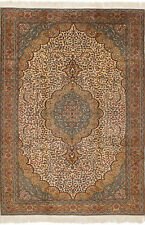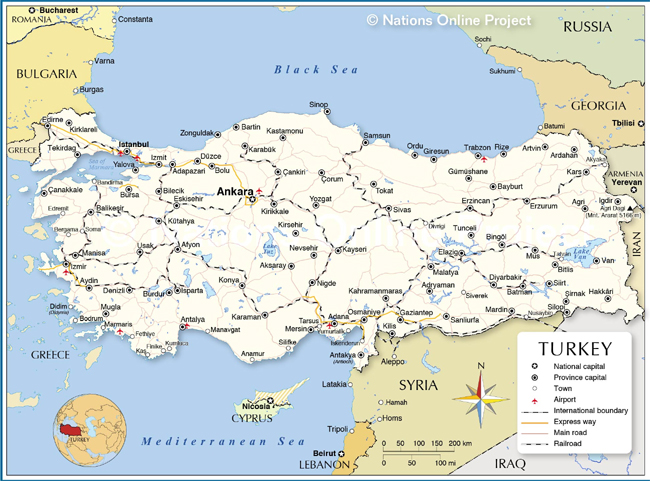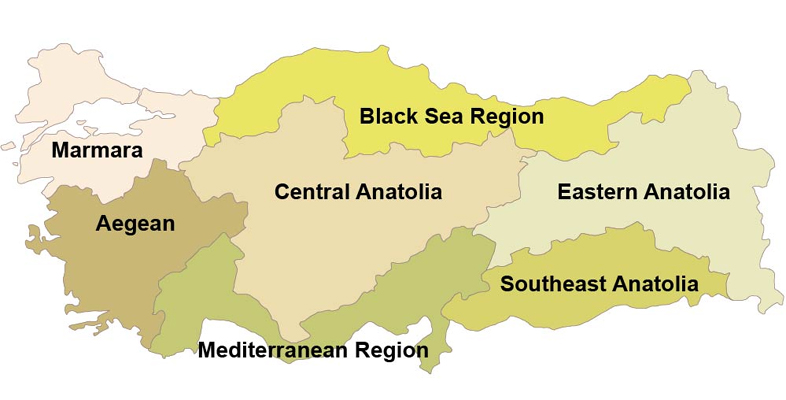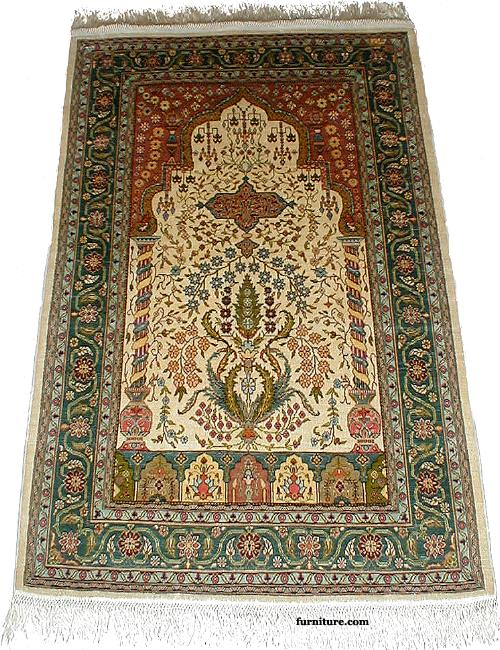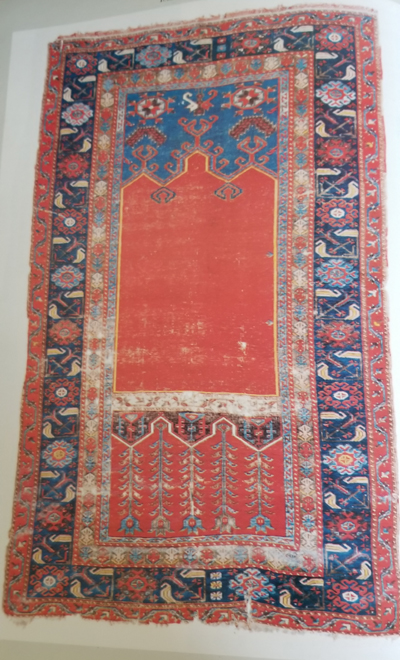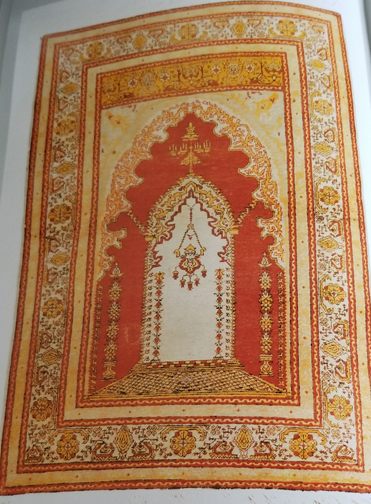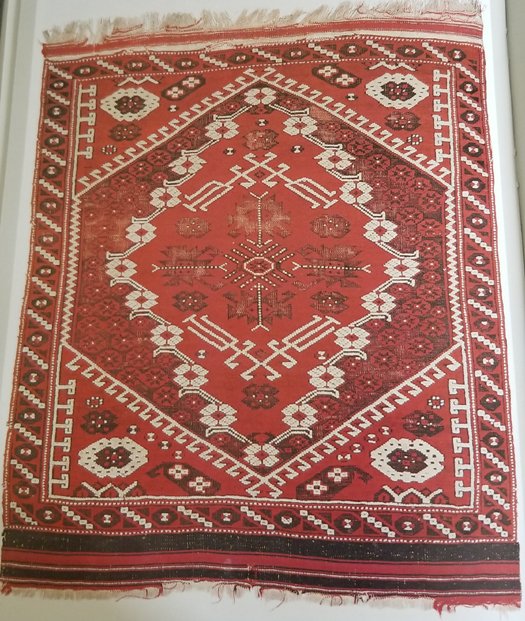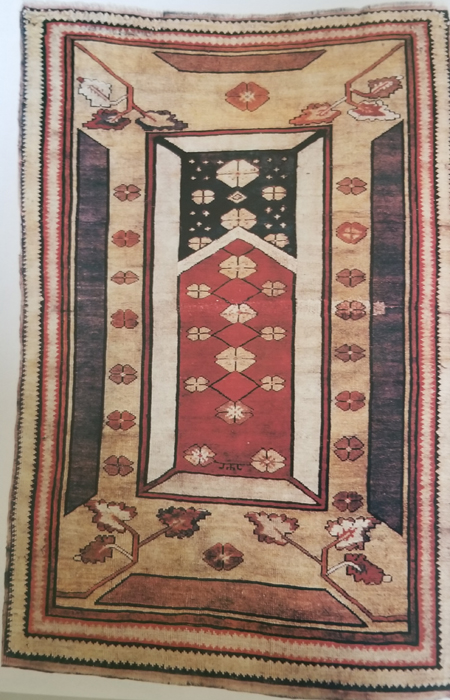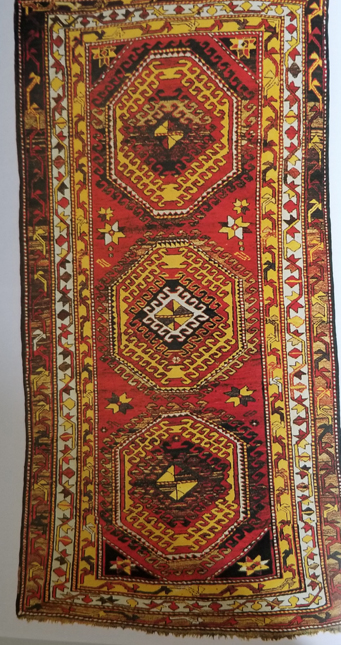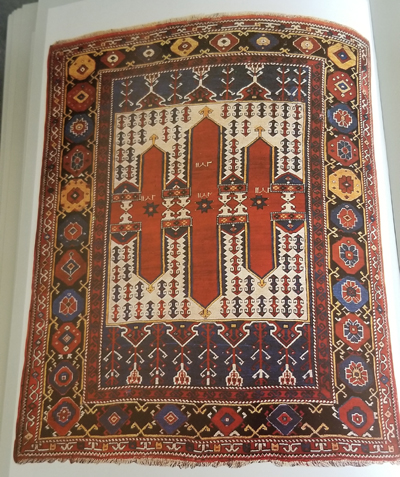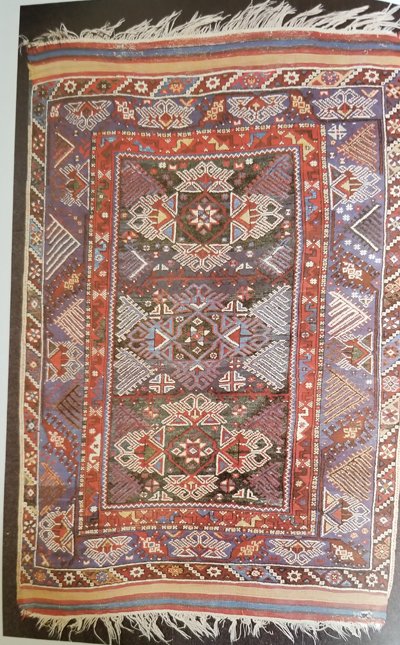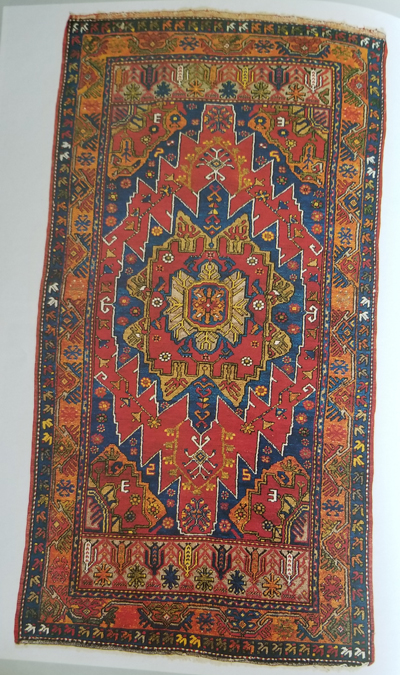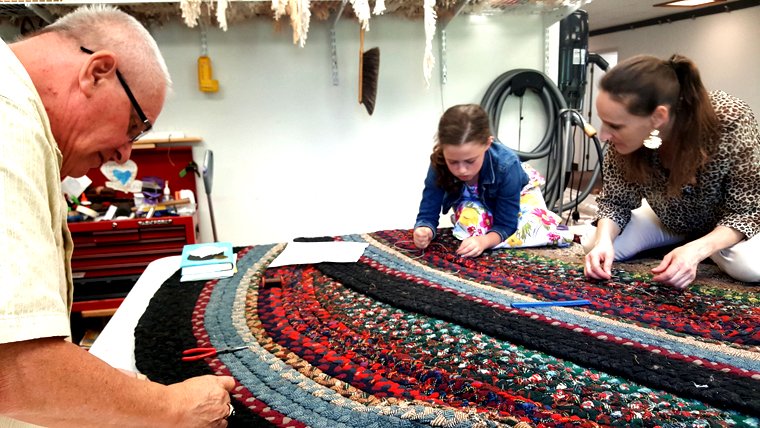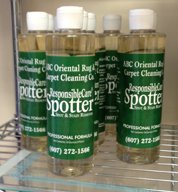TURKISH RUGS
EARLIEST RUGS
Turkish rugs, both flatwoven (or kilims with no pile) and hand-knotted rugs (with pile), have been woven in the various Turkish regions for centuries. Unfortunately, not enough evidence has thus far been obtained to provide the answer as to when these rugs actually first appeared.
Archaeological excavations have proven that flatwoven rugs (kilims) have been produced in the Anatolia region of Turkey since at least the Neolithic period.
The earliest specimens of hand-knotted rugs discovered thus far were in Turkish
regions in excavations carried out on Turkish burial mounds. This evidence
confirms the belief this first type of hand-knotted rug was most likely first woven and
used by the Turks.
NOMADIC CULTURE
Hand-woven textiles were a necessary household item for people living in Central Asia where the Turks originated. The migratory life of the nomads made it necessary to have on hand a variety of woven woolen textiles such as tents and pile rugs, as well as kilims (flatweaves), felts, coverings, sacks, and satchels.
The nomad Turks used the wool from their animals to weave rugs and they brought their rug weaving tradition with them when they migrated from Central Asia toward the West.
TURKISH RUGS - DESIGNS
The rug designs of the Turk nomads reflected their lives as influenced by the various climatic and geographic conditions they experienced. Along the way they also added influences from their new living conditions and the impact of local cultures. They thus continued their tradition, though with modified colors and designs.
The values of a particular weaving period may be reflected in the twist and quality of the wool, the manner in which the dye was manufactured, and from what plants or insects it was produced, the fineness or looseness of the stitch and, most important of all, the symbolic significance of the motif.
PIOUS ENDOWMENTS
The Turkish tradition of pious endowments is the major reason rugs have managed to come down to us from the depths of the past. The benefactors who, with their own modest resources, built the mosques to be found in even the smallest village. They then furnished them with rugs and kilims and added to these several of the finest specimens produced over the centuries by the looms in the various houses. There were also a number of prayer rugs specially woven for the mosques. It is thanks to this tradition of pious endowment that the cultural heritage of carpets and kilims has survived to the present day.
TURKISH RUG WEAVING TODAY
Today, rug weaving still continues in villages in Anatolia, although the number of carpets being made has been reduced.
It is noteworthy to mention the successful DOBAG project (a Turkish acronym for Natural Dye Research and Development Project,) which had produced superior carpets since 1981 with natural plant dyes and traditional Turkish motifs in the villages in northwestern Anatolia.
Unfortunately, as of the end of 2018, the annual production for the Dobag project was only 30 pieces, mainly woven by older weavers, and the project was essentially terminated.
REPUBLIC OF TURKEY TODAY
Turkey (officially the Republic of Turkey as of 1923) is a country mainly located on the Anatolian peninsula in Western Asia (also known as Asia Minor) with a small region in Thrace in the Balkan region of SE Europe.
Although in 1923, Turkey wished to be called Turkiye, it wasn't until December of 2021 that the country officially changed changed its name to Turkiye (tur-key-yay) in order to disassociate the name from that of the bird and to better represent its culture and values. (For our purposes, we will refer to 'Turkiye'as 'Turkey' in this article.)
Turkey is bordered by the Aegean Sea in the
west, the Mediterranean Sea in the south and the Black Sea in the north.
Armenia, Iran, and Azerbaijan are on the east, Georgia in the northeast,
Bulgaria and Greece in the northwest, and Iraq and Syria in the southeast.
Turkey shares maritime borders with Cyprus,
Egypt, Northern Cyprus, Romania, Russia, and Ukraine.
There are two narrow straits in northwestern Turkey, the Bosporus, which
connects the Black Sea with the Sea of Marmara, and the Dardanelles, which
connect the Aegean arm of the Mediterranean Sea with the Sea of Marmara.
Turkey is more than twice the size of Germany or slightly smaller than the US states of Texas and Louisiana combined. It has a population of more than 82 million people. The largest city is Istanbul. The second largest city and the national capital is Ankara.
Turkish is the official language with Kurdish and Arabic also spoken.
REGIONS OF TURKEY
Turkey can be subdivided into seven major
geographical regions:
MARMARA REGION
This region is the most densely populated in the country and is located in the northwestern part of the country on both the continents of Europe and Asia. Turkey’s largest city, Istanbul, is located here.
BLACK SEA REGION
This region is a long stretching mountainous region
along the Black Sea with a predominantly rural population. Major cities are
Samsun, a Black Sea port, the port city of Zonguldak, and Trabzon which was a
main port on the historical Silk Road.
AEGEAN REGION
This region is one of Turkey’s prominent tourism centers. It shares much of the history of Ancient Greece and is home to the city-states of Ephesus Miletus, and Bodrum (formerly Halicarnassus).
MEDITERRANEAN REGION
This region consists of a mountainous strip of land along the
Mediterranean Sea. The Taurus Mountain range in the region separates the Mediterranean
coastal area from the Anatolian Plateau. The Turkish Riviera, with the two
popular resort towns of Alanya and Antalya, is located here.
CENTRAL ANATOLIA
This historical region is the heartland of Turkey. It is home to the country’s capital, Ankara, and other major cities like Konya and Kayseri.
Cappadocia is also located in Central Anatolia. This is an ancient region between Lake Tuz and the Euphrates, famous for its ‘fairy chimneys’. Erosion has shaped the soft volcanic rock into thousands of strangely shaped towers and this area has become a favorite of hot-air balloon fans.
SOUTHEAST ANATOLIA
This region is also known as Turkish Kurdistan. It borders Syria in the south and Iraq in the southeast. In ancient times, Southeast Anatolia was part of the historical region of northwestern Mesopotamia, the site of the earliest urban civilizations. The world’s oldest stone structures were erected by an unknown civilization between 9,600 and 8,200 BCE, a time that predates Stonehenge by 6,000 years!
EASTERN ANATOLIA
This region was formerly part of western Armenia. It is the region with the lowest population density. The main economic activity is agriculture and animal husbandry. Van is a major city near the Turkish border with Iran and lies on the shores of Lake Van, the largest lake in Turkey and one of the world’s largest lakes with no outlet. The university town of Erzurum is located here and is a popular winter sports destination in Turkey.
MAJOR TURKISH RUGS
In other articles, we delve more deeply into some of the major Turkish rugs, their construction, colors, designs, motifs, etc.
The following are brief descriptions of some of the rugs we discuss:
HEREKE
The Town of Hereke is located about 45 miles from Istanbul in the Marmara Region. Hereke is still the most important rug weaving center for pure silk, wool, and cotton combination rugs.
LADIK
The city of Ladik, which is located approximately 20 miles northwest of Konya in the Central Anatolia Region and is one of the oldest rug weaving centers of Anatolia. It is particularly famous for its column rug motif and rugs with reserved tulip motifs. Rugs woven here have one of the most traditional designs ever produced in Turkey and are also extremely valuable.
KAYSERI
The Kayseri area is the most successful rug weaving region in Anatolia at this time and is located in Central Anatolia. It is well known for its pure silk, wool, and cotton rugs. A large portion of the population of the town makes their living from the rug trade. Medallion, floral, and mihrab (prayer) designs are very popular on Kayseri rugs.
YAGCI BEDIR
The pure wool of these rugs, in the mountain villages of the sindirgi region in the Aegean, are some of the best quality of their kind. Geometric designs, stylized birds and flowers, and stars are most typical patterns to be found on the Yagci Bedir rugs.
MILAS
The Milas (Melas) rug with its pastel colors and fine compositions has an important place in Anatolian carpet production. The warp weft, and knots of Milas rugs are pure wool. The dominant colors are tobacco color, dark and light brown, and reddish brown.
KARS
Kars is a provincial capital in the extreme northeast of Turkey. It was under Russian control for awhile during its history. Kars uses strong and durable wool. The traditional patterns of these Turkish rugs are large geometrical designs.
KULA
Kula is located on the road from Izmir to Ushak in the Aegean Region. Kula has developed its own style by the vertical arrangements of motifs. Due to their quality, Kula rugs have become one of the most desired rugs in foreign countries in the last 150 years.
DOSEMEALTI
Rug weaving villages of the Dosemalti are located about 13 miles in the north of Antalya in the Mediterranean region of Turkey. During all the centuries of the weaving of Turkish rugs, this region produces beautiful village and tribal rugs. They reflect the nomadic taste, which is expressed in geometric patterns with a color harmony of strong blues, dark greens, and reds.
YAHYALI
In the villages around Yahyali in Central Anatolia, almost every house has a rug weaving loom and rugs from these looms come to Yahyali to be sold. Yahyali weavers use pure wool and vegetal dyes for their rugs. The dominant colors are navy blue, red, and brown.
ABC CAN HELP WITH CLEANING & REPAIR OF
TURKISH RUGS
Our staff at ABC can answer questions you may have about your Turkish rugs. We can clean, treat, and repair all types and styles of area rugs, including oriental and Turkish rugs.
We are here for your convenience from 8am to 5pm Monday through Thursday, closing on Fridays at 4:30. We are also open from 10am to 1pm every Saturday.
We are located in Ithaca, New York at 130 Cecil Malone Drive. Please call or text us at 607-272-1566. You may Email us at rugladyvanessa@gmail.com
"The Cleanest Clean You've Ever Seen."
by
ABC Oriental Rug & Carpet Cleaning Co.
130 Cecil Malone Drive Ithaca, NY 14850
607-272-1566
ABC
Carpet & Rug
Spotting Guide
Learn how to remove spots with ordinary household solutions
Sign up below to gain access to your complementary Spotting Guide from ABC.
Registering your email address guarantees you will be notified whenever discount savings coupons become available.
Did you know that our ABC Responsible Care Spotter can get those pesky spots out of your carpet and rugs and will work equally as well on your clothes and upholstery?
Stop by our office and pick one up. They are $5.00 + Tax but if you have carpets or upholstery cleaned in your home or business, just request a free one from your Technician.
And don't forget to fill out the form above to download your free ABC Spotting Guide!
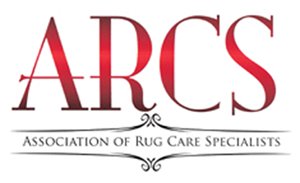
ABC Oriental Rug & Carpet Cleaning Co.
is a FOUNDING MEMBER of the
Association
of Rug Care Specialists.
"To Teach, Cultivate and Advance the Art and Science
of Rug Care"
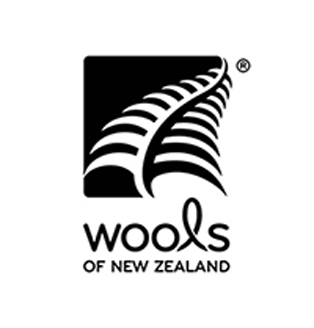
The Standard of Excellence
Oriental and Area Rug Washing at ABC Oriental Rug
Rugs on the wash floor are gently scrubbed before thorough rinsing.
Gentle scrubbing continues. Note the wringer in the background-the next step in the washing process after rinsing.
After thorough rinsing, the rug is sent slowly and carefully through the wringer to take out as much of the water as possible before being hung on racks in the drying room.
Rugs are hung on a rack in the temperature controlled drying room until completely dry.
